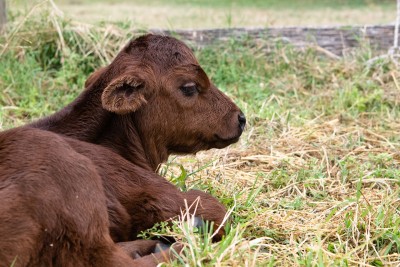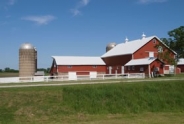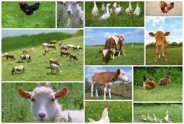Assessing (Beef) Calf Vigor, by Barry Whitworth, DVM

Assessing Calf Vigor
Barry Whitworth, DVM, Senior Extension Specialist, OSU Department of Animal and Food Sciences
In human medicine newborn babies undergo an APGAR test following birth. APGAR stands for appearance, pulse, grimace, activity, and respiration. The purpose of the test is to assess how well the baby tolerated the birthing process and how well the baby is doing outside the mother's womb. An APGAR test for calves similar to the one in human medicine would give cattle producers a clue when to intervene in a newborn's life. Unfortunately, most attempts to develop such a test for calves have not been successful; however, there are several studies that provide some practical advice on when to intervene with a newborn calf.
In two studies Dr. Homerosky and associates in Canada found two good predictors of calf vigor, calving ease and suckle reflex. Most producers have the ability to assess both components. First, was the calf born in a timely manner and required no assistance. Calves from births that require assistance are more likely to have acidosis. Acidosis is associated with failure of immunoglobulin absorption, sickness, and death in calves. Dr. Homerosky found a correlation between acidosis and the inability of a calf to withdrawal its tongue after being pinched. A producer can check a calf for acidosis by pinching the calf's tongue. If a calf cannot withdraw their tongue after being pinched, it is likely acidotic and is a good candidate for early colostrum intervention. Colostrum should be consumed in the first four hours following birth.
The second predictor a producers can check for is a strong suckle reflex. To measure the suckle reflex, a producer should insert two fingers in the mouth and rub the roof of the calf's mouth. A calf should have a strong jaw tone with a rhythmic suckle reflex. A weak suckle reflex indicates the need to feed colostrum.
In another study Dr. Murray found that calves that did not sit up (sternal recumbency) within 15 minutes of birth had reduced absorption of immunoglobulins. Also, calves born to cows that had difficulty birthing took longer to stand. These observations provide clues that the calf will require more care and colostrum intervention to increase the chance of survival.
Most producers are capable of assessing calf vigor based on the above parameters. Any calf born to a cow that has difficulty birthing and/or a calf that has problems with the above tests would be a candidate for early intervention. The best treatment is to give 2 to 3 liters of colostrum from the mother within the first 4 hours of life. Any delay in getting colostrum into the calf will only increase the chance of the calf having problems in life. This does require more work from the producer but should pay off with more pounds of beef at weaning.
References:
Homerosky ER, Caulkett NA, Timsit E, Pajor EA, Kastelic JP, Windeyer MC. Clinical Indicators of Blood Gas Disturbance, Elevated L-lactate Concentration and other Abnormal Blood Parameters in Newborn Beef Calves. The Veterinary Journal, January 2017 Vol.219: pp.49-57.
Homerosky ER, Timsit E, Pajor EA, Kastelic JP, Windeyer MC. Predictors and impacts of colostrum Consumption by 4H after Birth in Newborn Beef Calves. The Veterinary Journal, October 2017 Vol.218: pp.1-6.
Murray CF, Veira DM, Nadalin AL, Haines DM, Jackson ML, Pearl DL, Leslie KE. The Effect of Dystocia on Physiological and Behavioral Characteristics Related to Vitality and Passive Transfer of Immunoglobulins in Newborn Holstein Calves. Canadian Journal of Veterinary Research, April 2015 Vol.79(2): pp.109-119.
Upcoming Events
Crops, Cows & Critters - Southwest New York Dairy, Livestock & Field Crops Newsletter Sponsorship
December 19, 2025
January 30, 2026
Our two forms of publications feature research-based and timely information from our four specialists, listed to the right, along with local event notifications and Cornell University outreach. This information is provided to participants who range from dairy, livestock, and field crops producers to agricultural suppliers and consultants.
Weekly Email Update: Shared with 625+ households who have signed up with our program.
Monthly Paper Mailer: To reach our stakeholders and farmers who lack internet access, we send out a monthly mailer where your company's logo and contact information would be featured with a mailing list of 330+ households.
If you sponsor our weekly and monthly publications you reach approximately 955 households.
Visit our website to view our newsletters!
2025 Cornell Food Beverage & Animal Feed Manufacturer Survey
December 19, 2025
Industry and Educational Advocates for New York State's Food, Beverage, and Animal Feed Manufacturing industries:
As you know, NYS has a diverse food and beverage manufacturing industry, in both the types of industries that exist and the wide distribution of firms by scale. Many manufacturing firms have strong backward linkages to agricultural production sectors in the state that support both farm-level and downstream food industry firms and consumers. In collaboration with the New York State Department of Agriculture and Markets, a team from Cornell University's Charles H. Dyson School of Applied Economics and Management has recently rolled out the 2025 New York State Food, Beverage, and Animal Feed Manufacturer Survey. The industry will benefit from an updated assessment of the industry that informs private and public investments and opportunities to support firm growth and improved profitability.
Boots in the Barn: Cornell Dairy Research Updates
January 13, 2026
January 20, 2026
January 27, 2026
February 3, 2026
February 10, 2026
February 17, 2026
February 24, 2026
Join us for some or all!
Announcements
No announcements at this time.





